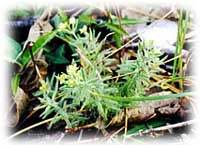
Lilium is a genus of herbaceous flowering plants growing from bulbs, all with large prominent flowers. They are the true lilies. Lilies are a group of flowering plants which are important in culture and literature in much of the world. Most species are native to the temperate northern hemisphere, though their range extends into the northern subtropics. Many other plants have "lily" in their common names, but do not belong to the same genus and are therefore not true lilies.

Lilium bulbiferum, common names orange lily, fire lily,Jimmy's Bane and tiger lily, is a herbaceous European lily with underground bulbs, belonging to the Liliaceae.

Lilium philadelphicum, also known as the wood lily, Philadelphia lily, prairie lily, or western red lily, is a perennial species of lily native to North America.

Lilium speciosum is an East Asian species of plants in the lily family. It is native to southern Japan and southern China, where it can be found at elevations of 600–900 metres (2,000–3,000 ft). It is sometimes called the Japanese lily though there are other species with this common name.

Lilium pardalinum, also known as the leopard lily or panther lily, is a flowering bulbous perennial plant in the lily family, native to Oregon, California, and Baja California. It usually grows in damp areas. Its range includes California chaparral and woodlands habitats and the Sierra Nevada.

Lilium michiganense is a species of true lily commonly referred to as the Michigan lily. It is a wildflower present in prairie habitats in the Great Lakes and Upper Mississippi Valley regions of the United States and Canada, from South Dakota through Ontario to New York, south to Georgia and Oklahoma.

Lilium pardalinum subsp. pitkinense, the Pitkin Marsh lily, is an endangered perennial herb of the family Liliaceae that is endemic to certain wetland areas in the northern California Coast Ranges of Sonoma County, California, United States. It is a subspecies of Lilium pardalinum.

Lilium columbianum is a lily native to western North America. It is also known as the Columbia lily, Columbia tiger lily, or simply tiger lily.

Lilium washingtonianum is a North American plant species in the lily family. It is also known as the Washington lily,Shasta lily, or Mt. Hood lily. It is named after Martha Washington and not the state of Washington; in fact, as the northern range of the plant is near Mount Hood in Oregon, it does not naturally occur in the state of Washington.

Arctostaphylos glandulosa, with the common name Eastwood's manzanita, is a species of manzanita.

Calochortus striatus, known by the common name alkali mariposa lily, is a species of mariposa lily native to California and into Nevada.
Erythronium pluriflorum is a rare species of flowering plant in the lily family Liliaceae which is known by the common names manyflower fawn lily,golden fawn-lily, and Shuteye Peak fawn lily.

Galium californicum is a species of flowering plant in the coffee family known by the common name California bedstraw.

Comarostaphylis diversifolia, known by the common names summer holly and California comarostaphylos, is a species of shrub in the heath family.

Lilium occidentale is a rare North American species of lily known by the common name western lily. Its species name 'Occidentale' means 'westernmost' and refers to its location along the West Coast. It is native to northwestern California and southwestern Oregon. It grows in coastal prairie habitat, swamps and stagnant bogs with Drosera species, bluffs and sandy cliffs, and seaside spruce forests. This rare wildflower is limited in distribution and directly endangered by a number of environmental factors. It is a federally listed endangered species and it is listed as endangered by the states of California and Oregon.

Lilium parryi, common name lemon lily, is a rare species of lily.

Orobanche californica, known by the common name California broomrape, is a species of broomrape. It is a parasitic plant growing attached to the roots of other plants, usually members of the Asteraceae.

Lilium monadelphum is a bulbous plant native to Crimea and to North and South Caucasus.

Cupressus stephensonii is a species of conifer known as the Cuyamaca cypress, and is endemic to southern California. It has been classified as Hesperocyparis stephensonii. It was previously listed as Cupressus arizonica subsp. stephensonii and Cupressus arizonica var. glabra.

Physaria kingii is a species of flowering plant in the family Brassicaceae known by the common name King bladderpod. It is native to western North America from Utah to Baja California, where it grows in dry and rocky habitat, such as deserts and adjacent mountain slopes. This is a perennial herb growing a small, hairy stem from a caudex. The leaves form a patch or rosette around the caudex, each up to 6 centimeters long and round, oval, diamond, or spoonlike in shape. The inflorescence is an erect or mostly upright raceme of bright yellow mustardlike flowers. The fruit is a hairy capsule under a centimeter long suspended on a short, often curvy pedicel.



















